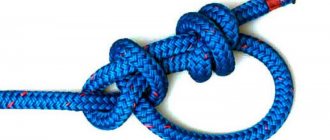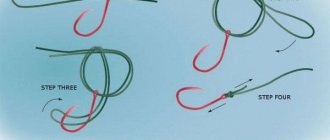Any fisherman cannot do his favorite job without knots. An experienced fisherman will always be able to reliably combine several types of fishing line in a fishing rod, tightly tie a hook, spoon or other tackle, and fix everything necessary on the fishing line.
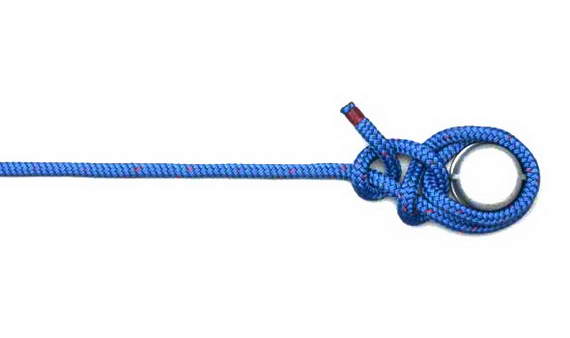
Garmin echo sounders and navigators
It is wise to tie the fish tank under the catch so that it does not come loose. Knowledge of knots is especially useful for those who go fishing in the sea. It is always necessary to have information on how to tie a knot correctly so that it does not come undone at the wrong time.
The article is devoted to the types of knots that will find their application not only in these situations. Each of the nodes can be considered unique, as it can be used anywhere.
We will tell you what a knot is, what type of knot is more appropriate to use in a given situation, as well as how to knit them correctly.
How to catch more fish?
I have been active fishing for quite some time and have found many ways to improve the bite.
But the most effective was and remains the BITE ACTIVATOR. It attracts fish in cold and warm water with the help of pheromones included in the composition and stimulates their appetite. Suitable for both summer and winter fishing. MORE ABOUT THE ACTIVATOR HERE. PRESS!
A knot is an old way of joining one or more ropes. It occurs by tying and intertwining the “running” and “root” ends of a rope, cord, or fishing line.
The running end is the loose part of the cable with which we form a knot. The root end is the second part of the cable, fixed in a stationary state.
All existing nodes are divided into groups according to their purpose. In our story we will talk about non-tightening knots, widely used in maritime and even fishing.
To be specific, we will consider the following nodes:
- A simple bayonet.
- A simple bayonet with a hose.
- A simple bayonet with two hooks.
- Bayonet with carryover.
- Fisherman's bayonet.
- A simple half bayonet.
When we have decided on the nodes, we can begin to analyze them in detail: what kind of node, how it is done, where it is used, step-by-step instructions for executing the node.
To create a strong, high-quality knot, you first need to familiarize yourself with the main principles and techniques of knitting knots.
How to knit a simple bayonet
Let's consider a situation where it is necessary to tie a simple bayonet on a vertical support.
This tying method will look like this:
- The running end of the rope is wound behind the support from left to right.
- The running end is thrown over the main end and inserted from below into the resulting loop - a so-called half-bayonet is obtained.
- The running end is moved to the right, its middle is taken in the right hand, and the end is again drawn to the left, thrown over the root and pushed from below into a new loop, forming a second half-bayonet, and at the same time forming a straight “simple bayonet” knot.
- For reliability, you can form a third half-bayonet, but usually two half-bayonets are enough.
- The running end is tied to the main control node. Now we can safely say that the rope is correctly and securely attached to the support.
Instead of a control knot, sometimes the running end of the rope is tied to the root end with a rope of smaller diameter. In this case, the half-bayonets that form a simple bayonet are not tightened at all - and the fasteners come undone without any problems even after heavy loads. An example of such fasteners is shown in the photo below:

This is often used by sailors when they attach a cable to a support, but I have not seen such an option in tourism: usually tying a knot ends with the formation of a control knot with the running end of the rope.
Sometimes, when the supply of rope is large and therefore it is inconvenient to knit the bayonet with the entire bay, this knot is knitted with a double end. That is, the free end of the rope is folded in half in a convenient place and a simple bayonet is knitted as if there was a single end instead of a double end.
Notes
- Kuryashkin Andrey Nikolaevich, Knot tying technique.
Theory and practice .
- Families. 2014. - p.49
. ISBN 978-601-80497-5-0 “Can the properties of the same node change, or does the node have constant, unchangeable characteristics? Strange as it may sound at first glance, the properties of most nodes may change under different conditions. It is impossible to say unequivocally about any knot that it is strong and reliable, or about another that it is weak and dangerous! It is always necessary to clarify that it is on such a rope that he behaves this way, it is under such circumstances and conditions that he begins to work this way. Each time, under different conditions, on different ropes - of different thicknesses and made of different materials, the characteristics of the same knot will be different. This must always be remembered. Therefore, if we say that this knot is strong, then we must add that it is on such and such a rope, if it is weak and not safe, then it is precisely under such and such conditions, etc.” - ↑ 1 2
Shamov A.P.
Methods and patterns of tying knots and their application in tourist equipment
: Textbook.
- Rostov-on-Don: RGPU, 2006. - p. 6
, 127 ill. ISBN 5-8480-0176-6 “The main property of a node is its functionality, that is, its clear purpose. Universalism can do a very bad job here. It is by this main property that nodes should be classified.” - ↑ 1 2
Ashley, Clifford W. (1944).
The Ashley Book of Knots
,
p.18
.
Doubleday. ISBN 0-385-04025-3 “The purpose for which a knot is used and the way in which it is tied, rather than its appearance, decide its classification” “The purpose of use
and the way of tying a knot determine its classification, not the pattern of the knot » - ↑ 1 2
Sleptsov I.V., Chernikov R.A.
Nodes in surgery
.
- St. Petersburg: Salit-Medkniga, 2000. - p. 10
ISBN 5-901306-01-5 “You can grab, intertwine threads and tighten a loop in different ways, so the formed loops may differ from each other” - ↑ 1 2
Ashley, Clifford W. (1944).
The Ashley Book of Knots
,
p.18
.
Doubleday. ISBN 0-385-04025-3 “The purpose for which a knot is used and the way in which it is tied, rather than its appearance, decide its classification” “The purpose of use and the way of tying a knot
determine its classification, not the pattern of the knot » - ↑ 1 2
Ashley, Clifford W. (1944).
The Ashley Book of Knots
,
p.12
. Doubleday. ISBN 0-385-04025-3 “At sea, the whole subject of knots is commonly divided into four classifications: hitsches, bends, knots, and splices” - Ashley, Clifford W. (1944). The Ashley Book of Knots
, p.12, 13, 18. Doubleday.
ISBN 0-385-04025-3 “The word knot has three distinct meanings in common use. In its broadest sense it applies to all complications in cordage, except accidental ones, such as snarls and kinks, and complications adapted for storage, such as coils, hanks, skeins, balls, etc. In its second sense it does not include bends, hitches, splices, and sinnets, and in its third and narrowest sense the term applies only to a knob tied in a rope to prevent unreeving, to provide a handhold, or (in small material only ) to prevent fraying. At sea, the whole subject of knots is commonly divided into four classifications: hitches, bends, knots, and splices (p.12). A hitch is a knot tied directly to or around an object; there are many hits that will capsize if removed from the supporting object (p.13). The purpose for which a knot is used and the way in which it is tied, rather than its appearance, decide its classification. This is clearly exemplified by three well-known knots of the same identical form: Bowline, Sheet Bend, Becket Hitch (p.18)" "The word knot
, in its third and narrowest sense, applies only to a thickening tied in a rope, to prevent unraveling.
… A bayonet
is a knot tied directly or around an object; There are many bayonets that untie themselves when removed from the object. ...The purpose of use and the method of tying a knot determine its classification, and not the pattern of the knot. This can be seen from three well-known identical knots: bowline, clew, and bequet bayonet.” - Ashley, Clifford W. (1944). The Ashley Book of Knots
,
p.12
, #12. Doubleday. ISBN 0-385-04025-3 “A hitch makes a rope fast to another object” - Ashley, Clifford W. (1944). The Ashley Book of Knots
,
p.12, 13
, #13, #25, #26.
Doubleday. ISBN 0-385-04025-3 “A bend units two rope ends. All knots called bends
are for lengthening rope, by tying two ropes together" "A joint connects the ends of two ropes together. Knots called 'splices' are designed to lengthen a rope by tying the ends of two ropes together." - Ashley, Clifford W. (1944). The Ashley Book of Knots
,
p.12
, #14, #15.
Doubleday. ISBN 0-385-04025-3 “The term knot
itself is applied particularly to knobs and loops, and to anything not included in the other three classes, such as fancy and trick knots.
For the purposes of this discussion the word knot
will be used in its broadest meaning, as an inclusive term for the whole subject, and the word
knob
will be used to designate a bunch tied in rope to prevent unreeving" ' applies especially to rope bulges and loops and anything not included in the previous 3 classes, such as intricate knots. For the purposes of this discussion, the word 'knot' is used in its broadest sense as a collective meaning for all knots, and the word 'bump' (stopper) is used to denote the thickening that prevents the end of a rope from snapping out of something." - Shamov A.P. Methods and patterns of tying knots and their application in tourist equipment
: Textbook.
- Rostov-on-Don: RGPU, 2006. - p. 6
, 127 ill. ISBN 5-8480-0176-6 - A. V. Lebedikhin, Fundamentals of mountaineering and rock climbing
, Textbook.
Ekaterinburg: State Educational Institution of Higher Professional Education USTU-UPI, 2004. p.46 - Ashley, Clifford W. (1944). The Ashley Book of Knots
, Doubleday,
p.9
, #1,2 ISBN 0-385-04025-3 “The Sheet Bend and the Weaver's Knot are structurally identical but are tied by different methods and in different materials, the former being tied in rope, the latter in thread or yarn.
tying
or
applying a form second knot" Different tying methods or uses form a separate knot.” - Ashley, Clifford W. (1944). The Ashley Book of Knots
, Doubleday,
p.84
, #516.
Double
called
a Blood
when used on a cat-o'-nine-tails, or on the snapper of an ox whip" ends of the whip" - Ashley, Clifford W. (1944). The Ashley Book of Knots
, p.18.
Doubleday. ISBN 0-385-04025-3 “The purpose for which a knot is used and the way in which it is tied, rather than its appearance, decide its classification. This is clearly exemplified by three well-known knots of the same identical form: Bowline, Sheet Bend, Becket Hitch” “The purpose of use and the method of tying a knot determine its classification, not the pattern of the knot. This can be seen from three well-known identical knots: bowline
,
clew
,
bequet bayonet
" - The manual describes the correct technique for tying knots during various surgical interventions. The technique of forming loops not only with the hands of a surgeon, but also with the use of various instruments is described. Attention is paid to special methods of tying knots during endoscopic operations. Numerous detailed illustrations make the material easier to understand. For surgeons and medical students
Basic mistakes
When knitting this knot, mistakes may be made. Let's look at the main ones.
Mistake #1. When knitting two half-bayonets at the root end of the rope, you get a cow knot instead of a bleached one (another name is “stirrup”).
This is a mistake: with a significant tension in the rope, the knot may become too tight, which means additional difficulties will arise when untying it.
Mistake #2. When knitting, instead of the maximum recommended three half pieces, four or more are knitted. The photo shows this error:
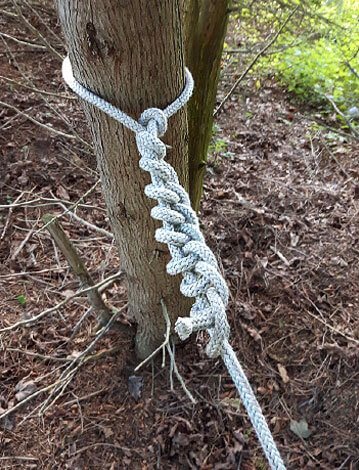
This is a mistake, since knitting more than three half-pins does not increase the reliability of the fastener, but only increases the time for tying and untying it.
Mistake #3. A control knot is not tied at the end of a simple bayonet, and the running end of the rope is not fixed to the main one in the previously recommended manner.
This is a mistake, because without “control” or fixing the running end of the rope, the fastener can still come undone under variable loads.
Double and triple bayonets
Also called a bayonet with a slag and a bayonet with two slags, respectively.
They differ from simple fastenings in that instead of one turn of the rope around the support, two or three are made. The photo below shows a bayonet with two hooks:

And here - with three:
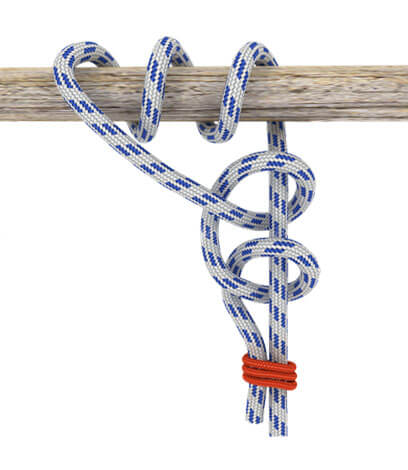
Thanks to the additional turns, these two options are more reliable, since the impact on the half-bayonets in the knot will be minimal due to the friction force of the rope at the points of contact with the support, and in this case the rope frays more slowly.
Fisherman's bayonet
Also known as the “anchor knot”, because it has long been used to attach an anchor. It is a double bayonet, in which the first half-bayonet is knitted by threading the running end into two loops draped over a support.
The fisherman's knot has the same advantages over a simple knot as the previous version. However, if instead of the control knot the running end of the rope is tied to the main one with a thinner rope, it has an additional advantage - it does not tighten at all, even under very heavy loads.
Simple bayonet with two slags
⇐ PreviousPage 4 of 6Next ⇒Designed for attaching a cable to an object.
In fact, this is also a type of simple bayonet. The difference from a simple bayonet with a hose is the additional third hose. It increases the strength of the knot if the cable experiences constant friction against the bollard or biting. Using this unit to attach the cable to the hook is a very reliable method.
Noose
Designed for attaching a cable to an object and lifting heavy objects. Most often to thick wood.
ATTENTION! It is considered dangerous if not secured with half bayonets.
A hundred years ago, in the sailing fleet, without this unit, the performance of many ship works would have been simply unthinkable. A noose with half bayonets, along with a retractable bayonet, was used on ships to lift up spar trees - topmasts, yards, gaffs, etc. It was used to tie logs in the water for towing, it was used to load cylindrical objects, and loaded rails and telegraph poles. The same knot was used for fastening the main ends of topsail sheets, topsail sheets and other gear where it was necessary to have the ends ready for quick return. A noose without half-bayonets was often used to secure the mooring line to the shore pole.
This knot, proven by centuries of experience at sea, has long been used on shore. It is widely used by lumberjacks. In many foreign languages, the name of this knot is “forest knot” or “log knot.” A noose with half bayonets is a reliable and very strong knot that tightens exceptionally tightly around the object being lifted. The running end of the cable must be passed over the root end inside the loop towards the object being clamped.
After the loop is surrounded by the running end 3 - 4 times, it is taken out of the loop and towards the far end, from which there will be traction. At the same time, it is very easy and simple to untie it when the pull on the cable stops. In order to lift a tree trunk of several tons or a heavy metal pipe without risking human life, it is not necessary to have any special rigging equipment for a crane. You can get by just fine with a plant cable of appropriate strength or a steel cable. But for this you need to be able to tie this knot correctly.
It should always be knitted slightly away from the middle of the log (pipe). Having removed the running end of the cable from the loop that makes up the knot, it is pulled towards the end of the object being lifted, from which there will be traction, and two half-bayonets are made. But, as a rule, two half-bayonets are made before the start of tying the noose, since the root end of the tackle is already secured. The slack of the cable between the noose and the half-bayonets must be selected before lifting.
Having lifted an object with a crane, it is better to deliver it to its place in one step, without lowering it to the ground. You should always remember that this unit must be checked before each lift (if it is carried out in two steps). It is also important in which direction to make half-bayonets on the log. They should be laid along the descent of the cable. Lifting heavy objects with a noose without half bayonets is considered dangerous.
Fisherman's bayonet. Anchor knot
Designed for attaching a cable to an object. Most often to the anchor, but you can lift the bucket from the well.
One of the most important cases of using a knot in maritime affairs is tying an anchor rope to an anchor. Over the five thousand years of shipping, people could not have come up with a more reliable knot for this purpose than this one. Tested by centuries of experience in maritime practice, this knot is recognized by sailors of all countries as the most reliable for attaching a rope to the eye or to the anchor shackle. A fishing bayonet (or anchor knot) is to some extent similar to a simple bayonet with a hook. It differs from it in that the first of the two half-bayonets additionally passes inside the hose that clasps the object. When using this knot for an anchor, it is always necessary to grab the running end with a grip to the main one. In this case, even with very strong traction, the fishing bayonet does not tighten and holds securely. It is fashionable to safely use it in all cases when working with cables when they are subject to strong traction.
Tightening noose
Tightening loop. Designed for attaching a cable to an object.
This knot is also called a scaffold or gallows knot. But despite this, it also finds other uses in maritime affairs. It is used when temporarily attaching a cable to objects floating in the water or when throwing and securing a cable to an object on the shore. This knot has an advantage even over such a good knot as a noose with half bayonets, in that the running end of the cable cannot slip out of the loop, and therefore a tightening noose is considered more reliable. On sailing ships, this knot was used to fasten the main ends of topsail sheets, topsail sheets and other gear in cases where it was necessary to have these ends ready for release.
To tie this knot, the cable is laid in the form of two loops of equal size. Both loops are surrounded several times with the running end of the cable, after which this end is passed into the loop facing the root part of the cable and, pulling out the outer loop, is clamped in it. A tightening noose can always be easily untied by pulling the main part of the cable. This gloomy knot can be well used in maritime affairs in two ways. Firstly, according to its knitting pattern, it is convenient to store the cable in the form of a compact coil. By making this knot without a loop on the running end of the throwing end, you get excellent heaviness. If you find it not heavy enough, dip it in water before use.
Stopper knot
Designed to increase the diameter of the cable to prevent slipping out of the block. This knot does not slip and holds securely. Similarly, you can tie a knot with three loops. Then it will be even larger in size. This may be necessary when the diameter of the hole through which the cable passes is much larger than the diameter of the cable. It can also come in handy when you need to make a comfortable handle at the end of the cable.
Straight knot
Designed for connecting two cables.
ATTENTION! A particularly dangerous knot (knits quickly, unties even faster)
Archaeological finds indicate that the Egyptians used it approximately three thousand years BC. The ancient Greeks and Romans called it Nodus Hercules - the Hercules or Hercules knot, because the mythical hero Hercules tied the skin of the lion he killed on his chest with it. The Romans used the straight knot to stitch wounds and heal broken bones. It consists of two half-knots, sequentially tied one on top of the other in different directions. This is the usual easiest way to knit it.
Sailors, who have been using this knot since ancient times to tie cables, use a different tying method. Weavers who use a straight knot to tie up broken threads of yarn tie it in their own, special way, convenient for them. When there are large loads on the connected cables, as well as when the cables get wet, the straight knot is greatly tightened. How can a straight (reef) knot be untied, which “is so tightened that it cannot be untied and will have to be cut.”
A straight knot, even if wet and tightly tightened, can be untied very simply, in 1 - 2 seconds. Tie a straight knot. Take ends A and B in your left hand, and ends C and D in your right hand. Pull them strongly in different directions and tighten the knot as tightly as possible. After this, take the root end, A, in your left hand (so that it does not slip out of your hand, make a couple of slings around your palm). Take running end B in your right hand (it can also be wound around your palm.). Pull the ends sharply and firmly in different directions. Without letting go of the end, A, from your left hand, with your right hand, squeeze the remaining part of the knot into your fist, holding it with your thumb and forefinger. The root end, and pull to the left - the knot is untied.
The whole secret is that when the ends A and B are pulled in different directions, the straight knot turns into two half-bayonets and completely loses all its properties. It also comes undone easily if you take the root end G in your right hand and pull the running end B strongly to the left. Only in this case, the end of G must then be pulled to the right, and the remaining part of the knot (half bayonets) - to the left. When untying a straight knot in this way, remember that if you pulled the running end to the right, pull the main end to the left and vice versa. When untying a straight knot, one should not forget that with the same force it was tightened, one of its running ends must be pulled with the same force.
Reef node
Quick untie knot. Designed for connecting two cables.
ATTENTION! A very dangerous node.
It got its name from the word “reef-shtert” - a small end of the cable tied into the canvas of the sail, which “took the reefs”, i.e., tied the part of the sail selected to the lower luff or to the boom in order to reduce its area in strong winds. On large straight-rigged sailing ships, reefs were taken using reef ropes - the flat ends of the cable, which were used to tie the luff of the sail to the reef line.
The reef ropes were tied in such a way that at any moment, if necessary, they could be untied or, as the sailors say, “torn apart.” A reef knot was used for this purpose. In maritime affairs, this knot is used for tying the tarpaulin covers of lifeboats, winches, compasses and other instruments on the upper navigation open bridge. This knot is commonly known as a “knot with one bow.” It’s familiar to everyone; many tie their shoelaces with it. In principle, this is a simple and useful knot.
Portuguese bowline
Non-tightening double loop. Similar to a simple bowline. It is used in cases where you need to tie two loops at one end.
Works the same as a simple bowline. It is used in cases where it is necessary to tie two loops at one end at once. For example, lifting a wounded person. Then the victim’s legs are threaded into loops, and a half-bayonet is tied around the chest under the armpits with the root end. then the person will not fall out anywhere, even if he is unconscious.
Topographical signs.
When reading a topographic map of an area, you need to navigate its conventional images, called topographic signs or abbreviated topographic signs. The need to study them is undeniable, as it allows you to skillfully and quickly navigate the terrain: determine your location and distance to your destination, and plot a short and convenient route.
A tourist who knows topographical signs well and has an accurate map is a reliable guide and navigator as part of a tourist group. Moreover, any person with initial orienteering skills will be able not only to navigate on the map, but also to create their own plans and diagrams of the area, if necessary.
The simplest example: a car breaks down off-road in an unfamiliar area and cannot reach its destination under its own power. You can leave it, but not lose it, by drawing up a map of the area indicating convenient landmarks (a lonely tree, etc.), then return with help and save the car.
You can also create diagrams of convenient places for fishing and tourist camps. The most tragic case - the impossibility of transport of a wounded comrade and the search for help is also solved with the help of basic navigation skills using topographic signs.
⇐ Previous4Next ⇒
Didn't find what you were looking for? Use Google search on the site:
Bayonet with drift
Its knitting pattern is as follows: at the beginning, the running end is turned around the support, then it is thrown over the root and again circled around the support, but in the opposite direction, after which the half-bayonets are knitted, as in the case of a simple knot.
The advantages of this knot over a simple one are the same as those of a bayonet with a hose, with the only difference being that the bayonet with a hose slides a little less when the load changes direction, including due to the fact that the loops of the rope wrap around the support on both sides of the root end to which the load is applied.
"A simple bayonet with a slag"
A “simple bayonet with a hose” differs from a simple bayonet only in the additional hose. A rope is a turn of a rope around a fixed object.
Simple bayonets with slings are used when it is necessary to firmly tie a rope to a stationary object, for example, a boat to a pier.
This knot can be remembered by those fishermen who go out to fish on a vessel and do not want it to leave the pier without its owner at some point. A correctly tied simple bayonet with a hose does not tighten even with prolonged tension.
Like other types of knots, a bayonet with a hose has the advantage that it can be untied without any extra effort. Despite the fact that this knot can hardly be called reliable, it is still in demand among sailors and fishermen.
In order to avoid unpleasant situations, we give advice: to increase the level of reliability of the knot, before securing the ends, tighten the knot.
How to knit “Simple bayonet with hose” correctly:
- Wrap the running end around the object from back to front;
- Make two more turns in the same direction;
- Form a half-bayonet around the main end with the running end;
- Make another half-bayonet at the root end;
- Tie both ends tightly with thin twine;
- Tighten the knot.
- Congratulations, the node is ready!
Wet half bayonet
This option is an untied bayonet with a carryover, where instead of two half-bayonets, one is tied, with a double running end. Instead of a control knot in this case, you can insert the running end of the rope into the loop emerging from the half-bayonet, formed by the double end.
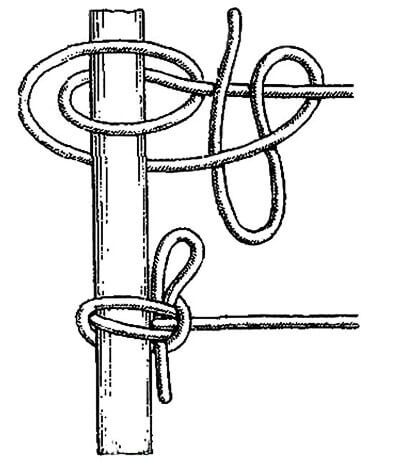
The beauty of this knot is how easy it is to untie.
This fastener, in comparison with a simple and a bayonet with a bayonet, can be easily and quickly untied even with a very high rope tension. To do this, simply remove the running end from the loop and pull it.
Literature
In Russian
- Richard Hopkins.
The art of tying knots = Knots. - M.: Eksmo, 2007. - 256 p. — 5,100 copies. — ISBN 5-699-17708-6, BBK 37.279. - Skryagin L.N.
Sea knots. — Ed. 3rd. - M.: Transport, 1994. - 128 p. — ISBN 5-277-01807-7. - A.V. Lebedikhin, Fundamentals of mountaineering and rock climbing
, Textbook. Ekaterinburg: State Educational Institution of Higher Professional Education USTU-UPI, 2004. 130 p. - Balabanov Igor Vladimirovich, Knots
. Moscow, 43 p. ISBN 5-901049-27-6 - Sleptsov I.V., Chernikov R.A. Nodes in surgery
. [16] - St. Petersburg: Salit-Medkniga, 2000. - 176 p. ISBN 5-901306-01-5
In foreign languages
- Clifford W. Ashley The Ashley Book of Knots
. Faber and Faber, London & Boston. ISBN 0-385-04025-3 - R. S. Lee. All The Knots You Need
. Algrove Publishing. ISBN 0-921335-47-4 - Raoul Graumont. Handbook of Knots
. Cornell Maritime Press/Tidewater Publishers. ISBN 0-87033-030-6 - Cyrus L. Day. Knots & Splices
. International Marine/McGraw-Hill Companies. ISBN 0-87742-252-4 - Geoffrey Budworth (1999). The Ultimate Encyclopedia of Knots & Ropework
. Annes Publishing Limited. ISBN 1-55267-986-1 - John Cassidy (1985). The Klutz Book of Knots
. Klutz Press, Palo Alto, California. ISBN 0-932592-10-4 - Des Pawson (2001). Pocket Guide to Knots & Splices
. Produced for Propsero Books by RPC Publishing Ltd., London. ISBN 1-55267-218-2 - Brion Toss. The Complete Rigger's Apprentice
. International Marine/McGraw-Hill Companies. ISBN 0-07-064840-9 - Allen Padgett and Bruce Smith. On Rope
. National Speleological Society. ISBN 0-9615093-2-5
Reverse bayonet
This is nothing more than an “inverted” bayonet with a run-out.
The reverse bayonet is used mainly in maritime affairs, when difficulties arise when carrying the main end of the cable around the support to which it must be attached. Due to the peculiarities of knitting this knot, the support needs to be walked around only once, while when knitting a bayonet with a run-out, it would have to be walked around the support twice.
It has the same advantages over a simple knot as a bayonet with a run-out, but compared to the second, as was said earlier, under certain conditions the reverse version is more convenient for tying.
Bed bayonet
This option was preferred to be tied for hanging bunks on ships, which is how it got its name.
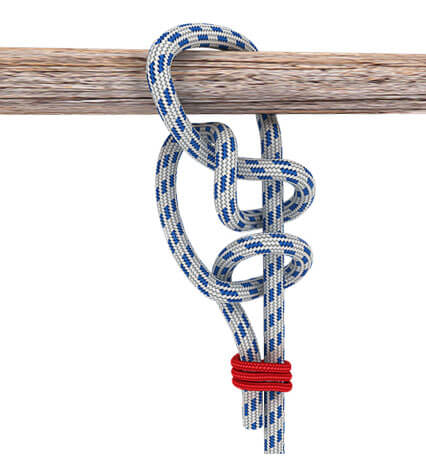
The difference in knitting this knot from the simple version comes down to the fact that instead of the initial simple knot, a figure eight is knitted around the support.
Perhaps this option has some advantages over a simple bayonet, since it was very popular among sailors for a long time, but personally, when using this fastener in practice, I did not find any. The only drawbacks I found were primarily related to the more complex and lengthy knitting of the bed bayonet.
Mast bayonet
The mast bayonet consists of two “stirrup” knots: one is tied on the support, the second - on the root end of the rope. Actually, as was noted earlier, the stirrup at the root end of the rope is knitted with two half-bayonets, both in a simple bayonet and in some of its other variants.
The advantage of a mast bayonet over a simple one again lies in the additional lags (turns) of the rope around the support, due to which the rope frays more slowly. In addition, thanks to the stirrup thrown over the support, the impact on the half-bayonets tied at the root end of the rope will be less than in other knot options discussed earlier.
If you tie a control knot at the end, the mast bayonet will tighten and tightly clamp the support, preventing the rope from sliding in any direction. But in this case, it will be more difficult to untie the knot.
If, after forming the mast bayonet, the running end of the rope is tied to the main one, then the knot will not tighten even with very large loads on the rope, and after loosening the rope it can be easily untied.
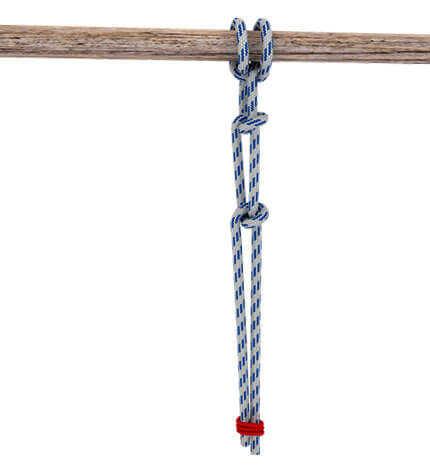
A mast bayonet is a combination of a double bayonet and a stirrup.
There are other units, the name of which contains the word “bayonet”, but which in themselves are not “relatives” of a simple bayonet. Such units include, for example, a sliding bayonet and a flat bayonet. We will not consider them within the framework of today's topic.
As you can see, there are many known bayonets, each of which has its own advantages and disadvantages. However, there is no point in memorizing all the options: for a tourist or a person interested in survival in the wild, it will be enough to remember two or three nodes from this category.
Personally, I would recommend only one option for memorization - a bayonet with a carryover. On the basis of this knot, if necessary, it is easy to tie a simple bayonet, and the fastening pattern on the support itself is the basis for the UIAA knot and the Prusik knot, which are used for descending and ascending a rope. If you know and are able to knit a bayonet with a bow, it will be easier to remember these knots.
Author: Maxim Chechetov
Classification
- According to Ashley's book of knots, knots can be classified into 4 classes:[6]
- Bayonets
(
hitches
) - attach a rope to an object[8] - Connections
(
bends
) - connect the ends of the ropes together[9] - Knots
a
,
decorative knots[10] - Splices
-
ogons _
- According to A. Shamov’s book “Methods and patterns of tying knots and their application in tourist equipment,” in mountaineering, knots are divided into 3 classes:[11]
- The main knots
are non-tightening loops at the end or middle of a climbing rope for belay (figure eight) - Auxiliary
- tightening knots to thicken the rope (a double simple knot as a control knot that prevents the main knot from untying) - Special
- braking units for descent or belaying (UIAA unit)
- According to the book by A. Lebedikhin “Fundamentals of Mountaineering and Rock Climbing”, in mountaineering knots are divided into 3 groups:[12]
- Knots for tying
(figure eight) - Tying knots
(grapevine) - Auxiliary nodes
(UIAA node)
By purpose
- Thicken the rope (simple knot)
- Tie a rope to an object (blend knot)
- Tie an object for lifting with your hands, or using a lifting mechanism (barrel knot)
- Tie two ropes together of the same diameter and material (grapevine)
- Different diameters and materials (tailgate assembly)
- Tightening loop (running bowline)
Designated for decorative purposes
knots: there is a separate classification of tie knots (Windsor).
Nodes are classified by application; the same knot, but tied in different ways[4][5] or on different materials or for different purposes[2][3], differs from each other, for example:
- By using one knot, tied differently on different materials for different purposes, 2 knots are formed: the weaver's knot, the clew knot.[13]
- Using one knot, 2 knots are formed: double simple knot, blood knot.[14]
- Using one knot, 3 knots are formed: bowline, clew knot, becket knot.[15]
By connector
- Quick-release (reef knot) Remote release - one end of the rope can withstand a considerable load, but if you pull the second, the knot will come undone (bucket knot)
In terms of reliability
| This section is missing references to information sources. Information must be verifiable, otherwise it may be questioned and deleted. You may edit this article to include links to authoritative sources. This mark was set on March 6, 2020 . |
Some knots tend to unravel themselves or damage the rope. In the days of the sailing fleet, it was believed that a simple knot reduced the reliability of the rope by 2 times [ source not specified 229 days
];
a straight knot is reliable enough only when tying luggage, and neither sailors nor climbers use it to tie two ropes. And a woman’s knot, similar to it and often tied by inept people, slips and unties very easily. Both straight and woman's knots have claimed more than one human life [ source not specified 203 days
].
On the use of rope components
- Using the entire rope
- Requiring unraveling of the rope into strands (braid). Such knots are more complex, but stronger and more compact than conventional knots.


